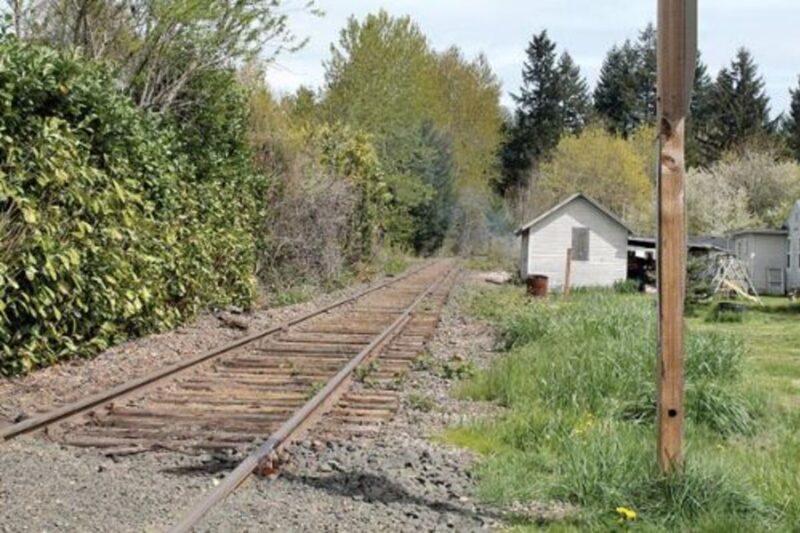Sean C. Morgan
Albany and Eastern says clearing of trees and other objects necessary for safety, legal reasons
Albany and Eastern Railroad has been clearing its right-of-way along its rail line west of Sweet Home along Highway 20 for the last two weeks, causing some consternation for local residents, prompting some to call or stop in at The New Era to voice concerns.
The railroad company is clearing brush and trees along the rail line, and it will continue clearing the right-of-way along the line throughout Sweet Home.
The railroad is clearing the brush and trees for safety purposes and to minimize hazards for both railroad employees and drivers, said spokesman Jared Cornell. In some places, drivers have to pull onto the railroad tracks to see around trees.
“All of the clearing we’ve done is for safety reasons,” said Cornell.
“We’re going to clear it all,” he said, adding that workers are only clearing railroad property, which is generally 50 feet on each side of the track.
The right-of-way narrows to about 25 feet in Foster and is wider in some locations, including one in Foster.
Where it narrows, “we’re only going to clear it on railroad property,” Cornell said.
Off of railroad property, blocked vision areas are regulated by the city, and keeping clear vision areas clear off of rail property is the city’s responsibility, he said.
The railroad is concerned with hedges and vegetation on its right-of-way, he said. The narrow right-of-way in Foster is not unusual.
Vegetation in the right-of-way also poses a fire hazard during the summer months, Cornell said. Potential sparks from a train can start a fire. That occurred last summer near Brewster Road in the Lebanon area.
The railroad’s clearing efforts follow federal regulations, he said. The regulations clearly state the railroad must clear the right-of-way of brush.
Photo by Sean C. Morgan
FALLEN TREES await removal along the Albany and Eastern Railroad line west of Sweet Home.
complaining that the railroad is clearing the trees for the timber.
Cornell said he has had a couple of people contact him
That is false, he said. The company is losing money in the effort, since the value of the timber isn’t enough to pay for the clearing.
“People will be upset because we’re changing the view,” Cornell said. “I totally understand. At the same time, we’ve got to take care of our safety needs and our liability.”
Prior to starting the clearing, the railroad identified key areas with marketable timber, Cornell said. Then it went to work getting larger trees out of the areas with vision and fire issues. Later, it will go back for the smaller vegetation and to remove stumps.
In the Narrows, the railroad right-of-way extends to the river in some places, Cornell said. The railroad will take some of the trees.
“We want to make sure we stabilize the slope,” Cornell said. When the railroad logs that area, it will be careful to take only the trees it has to and will leave the stumps behind in an effort to avoid destabilizing the bank, protecting the riparian area and leaving shade for the river.
In addition to vegetation, Albany and Eastern is also dealing with encroachment into the right-of-way from neighboring properties.
There are pump houses, sheds and garages built on railroad property, Cornell said. “The folks, in general, they know who they are.”
He asks that people with structures on the right-of-way to contact the railroad.
“In some cases, we’ll be able to give them an easement,” he said. In most cases, if the property owner has insurance for a crossing, the insurance will also be sufficient for the easement. The railroad will charge $120 per year for the easement unless it’s commercial.
“It’s classic encroachment,” he said. Someone says, “Well, I’m just going to put this here.”
The property changes hands five or six times, and it’s a surprise to the latest owner to find out it’s on railroad right-of-way, Cornell said. “I feel for those folks.”
But it is railroad property, and buyers need to look at the paperwork when they buy, Cornell said. Everything is surveyed and marked now.
Among those dealing with right-of-way issues are Donna Kibler and her husband, who live off Highway 20 between Dew and Harmony roads and have maintained a crossing permit since they bought their home 11 years ago.
“They took all the trees,” Kibler said. “They notified us we had to move our fence or they’d knock it down.”
Her husband was busy moving the fence with the help of neighbors over the weekend.
The railroad took down some 20 trees in front of the Kibler home, she said, and the railroad was scheduled to return Monday to remove an 80- to 100-year-old tree. She planted the bulk of the trees about 10 years ago as a sound break, and she has maintained the vegetation and planted flowers there during the past decade.
“I don’t see why they need to take them,” Kibler said. The older tree is 45 feet from the track and partially on the Kiblers’ property. “They’re claiming it’s a hazard.”
She could see dealing with the shrubbery or trees within about 30 feet of the rail, she said, and she thinks the railroad is taking the trees out of spite.
“They’ve just destroyed all the flowers that were down there to keep it clean,” Kibler said. “His attitude is, it’s mine, I’m going to do what I want.”
Some neighbors of the railroad right-of-way are disputing charges the railroad is imposing for crossing permits and maintenance.
Cornell said the railroad wants to cooperate with residents.
“I’m trying to encourage people to contact us if they have questions or concerns,” Cornell said. “Call us. We’ll work with people. We really will.”
The railroad office may be contacted at (541) 259-6470.





